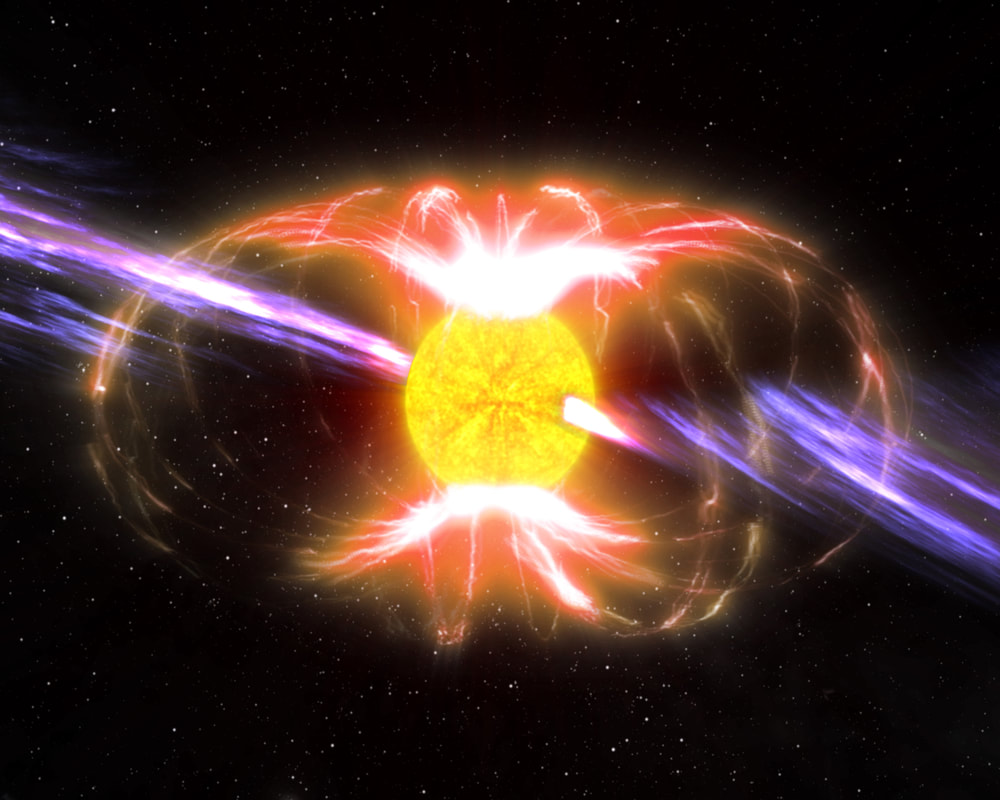Mysterious spinning neutron star detected in the Milky Way proves to be an extremely rare discovery7/7/2020 On March 12th 2020 a space telescope called Swift, detected a burst of radiation from half-way across the Milky Way. Within a week, the newly discovered X-ray source, named Swift J1818.0–1607, was found to be a magnetar: a rare type of slowly rotating neutron star with one of the most powerful magnetic fields in the Universe. Spinning once every 1.4 seconds, it’s the fastest spinning magnetar known, and possibly one of the youngest neutron stars in the Milky Way. It also emits radio pulses like those seen from pulsars--another type of rotating neutron star in our galaxy. At the time of this detection, only four other radio-pulse-emitting magnetars were known, making Swift J1818.0–1607 an extremely rare discovery. In a recently published study led by a team of scientists from the ARC Centre of Excellence for Gravitational Wave Discovery (OzGrav), it was found that the pulses from the magnetar become significantly fainter when going from low to high radio frequencies: it has a ‘steep’ radio spectrum. Its radio emission is not only steeper than the four other radio magnetars, but also steeper than ~90% of all pulsars! Additionally, they found the magnetar had become over 10 times brighter in only two weeks. Comparatively, the other four radio magnetars have almost constant brightness at different radio frequencies. These observations were made using the Ultra Wideband-Low (UWL) receiver system installed on the Parkes radio telescope, also known as ‘The Dish’. Whereas most telescopes are limited to observing radio waves across very narrow frequency strips, the Parkes UWL receiver can detect radio waves across an extremely wide range of frequencies all at the same time. After further analysis, the OzGrav team found interesting similarities to a highly energetic radio pulsar called PSR J1119–6127. This pulsar underwent a magnetar-like outburst back in 2016, where it too experienced a rapid increase in brightness and developed a steep radio spectrum. If the outburst of this pulsar and Swift J1818.0–1607 share the same power source, then slowly over time, the magnetar’s spectrum should begin to look like other observed radio magnetars. The age of the young magnetar (between 240-320 years), was measured from both its rotation period and how quickly it slows down over time; however, this is unlikely to be accurate. The spin-down rates of magnetars are highly variable on year-long timescales, particularly after outbursts, and can lead to incorrect age estimates. This is also backed up by the lack of any supernova remnant—remnants of luminous stellar explosions—at the magnetars position. Lead author of the study Marcus Lower proposed a theory to explain of the magnetar’s mysterious properties: ‘Swift J1818.0–1607 may have started out life as a more ordinary radio pulsar that obtained the rotational properties of a magnetar over time. This can happen if the magnetic and rotational poles of a neutron star rapidly become aligned, or if supernova material fell back onto the neutron star and buried its magnetic field’. The buried magnetic field would then slowly emerge back to the surface over thousands of years. Continued observations of Swift J1818.0–1607, over many months to years, are needed to test these theories.
1 Comment
|
|
- Home
- About
-
Our People
- Chief Investigators
- Partner Investigators
- Associate Investigators
- Postdocs and Students >
- Professional & Outreach staff
- Governance Advisory Committee
- Scientific Advisory Committee
- Executive Committee
- Equity & Diversity Committee
- Early Career Researcher Committee
- Professional Development Committee
- Research Translation Committee
- OzGrav Alumni
- Research Themes
- Education and Outreach
- Events
- News/Media
- Contact Us
- Home
- About
-
Our People
- Chief Investigators
- Partner Investigators
- Associate Investigators
- Postdocs and Students >
- Professional & Outreach staff
- Governance Advisory Committee
- Scientific Advisory Committee
- Executive Committee
- Equity & Diversity Committee
- Early Career Researcher Committee
- Professional Development Committee
- Research Translation Committee
- OzGrav Alumni
- Research Themes
- Education and Outreach
- Events
- News/Media
- Contact Us


 RSS Feed
RSS Feed








